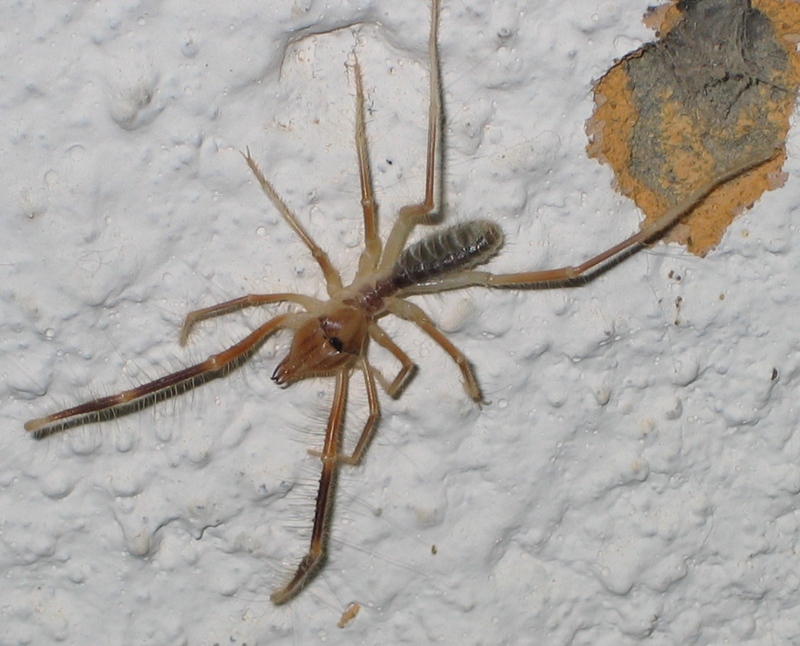Camel Spider (Order: Solifugae) - Wiki Solifugae
From Wikipedia, the free encyclopedia
[Photo] Solfuga, gatunek nieznany. SW Iraq, Summer 2004. Autor: CM
The order Solifugae is a group of arachnids, containing around 900 species. The name derives from Latin, and means those that flee from the sun. The order is also known by the names Solpugida, Solpugides, Solpugae, Galeodea and Mycetophorae. Their common names include camel spider, wind scorpion, and sun spider.
Solifugae are not true spiders, which are from a different order, Araneae. Like scorpions and harvestmen, they belong to a distinct arachnid order.
Most Solifugae inhabit warm and arid habitats, including virtually all deserts in both the Eastern and Western Hemispheres, but some species have been known to live in grassland or forest habitats. The most distinctive feature of Solifugae is their large chelicerae. Each of the two chelicerae are composed of two articles forming a powerful pincer; each article bears a variable number of teeth. Solifugae also have long pedipalps, which function as sense organs similar to insects' antennae and give the appearance of the two extra legs. Pedipalps terminate in eversible adhesive organs.
Solifugae are carnivorous or omnivorous, with most species feeding on termites, darkling beetles, and other small arthropods, although solifugae have been videotaped consuming larger prey such as lizards, and even mice. Prey is located with the pedipalps and killed and cut into pieces by the chelicerae. The prey is then liquefied and the liquid ingested through the pharynx.
Reproduction can involve direct or indirect sperm transfer; when indirect, the male emits a spermatophore on the ground and then inserts it with his chelicerae in the female's genital pore.
As indicated by their name, Solifugae are mostly nocturnal, and seek shade during the day. It was this behaviour which led coalition soldiers in the 2003 invasion of Iraq to think these arachnids were attacking them. In reality, they were merely moving toward the newly available shade provided by the soldiers' presence. The absence of shade sends them away.
Myths
Solifugae are the subject of many myths and exaggerations about their size, speed, behavior, appetite, and lethality. They are not especially large, the biggest having a legspan of perhaps 12 cm. They are fast on land compared to other invertebrates, the fastest can run perhaps 10 miles per hour (16 km/h), nearly half as fast as the fastest human sprinter. Members of this order of Arachnida apparently have no venom, with the possible exception of one species in India (see below) and do not spin webs.
In the Middle East, it was once rumored among American and coalition military forces stationed there that Solifugae will feed on living human flesh. The story goes that the creature will inject some anaesthetizing venom into the exposed skin of its sleeping victim, then feed voraciously, leaving the victim to awaken with a gaping wound. Solifugae, however, do not produce such an anaesthetic, and they do not attack prey larger than themselves unless threatened. Other stories include tales of them leaping into the air, disemboweling camels, eerie hissing, and screaming.
Due to their bizarre appearance many people are startled or even afraid of them. The greatest threat they pose to humans, however, is their bite in self-defense when one tries to handle them. There is no chance of death directly caused by the bite, but, due to the strong muscles of their chelicerae, they can produce a proportionately large, ragged wound which is prone to infection.
Venom controversy
While the absence of venom in Solifugae is a long-established fact, there is a single published study of one species, Rhagodes nigrocinctus, carried out in India in 1978 by a pair of researchers who did histological preparations of the chelicerae, and found what they believed to be epidermal glands (Aruchami & Sandara Rajulu 1978). Extracts from these glands were then injected into lizards, where it induced paralysis in 7 of 10 tests. While this study has never been confirmed, and while other researchers have been unable to locate similar glands in other species, this particular species does appear to possess venom, although it is not known if there is any mechanism for introducing it into prey (recall that the researchers manually injected it into lizards).
Classification
There are twelve families belonging to the order Solifugae:
Ammotrechidae
Ceromidae
Daesiidae
Eremobatidae
Galeodidae
Gylippidae
Hexisopodidae
Karschiidae
Melanoblossidae
Mummuciidae
Rhagodidae
Solpugidae
In popular culture
A fictional species of Solifugae played a role in the second episode of the Science Fiction show Primeval. A nest entered the present through an anomaly leading to the Carboniferous. The adults were up to 1 metre wide, by 1 metre long, because the lush rainforest of the Carboniferous saturates the atmosphere with oxygen, allowing them to grow larger than modern arthropods. The Solifugae's aversion to sunlight and lack of venom were major plot points in that episode.
http://en.wikipedia.org/wiki/Solifugae
| The text in this page is based on the copyrighted Wikipedia article shown in above URL. It is used under the GNU Free Documentation License. You may redistribute it, verbatim or modified, providing that you comply with the terms of the GFDL. |
